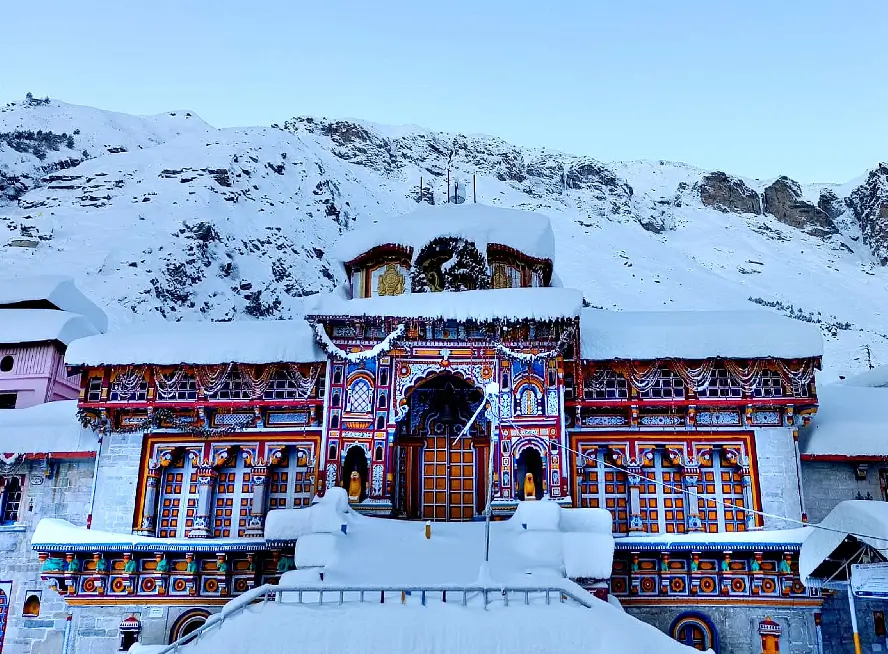Journey to Divinity: Unraveling the Mystique of Badrinath Temple
Introduction:
Nestled amidst the awe-inspiring Himalayan peaks in the Chamoli district of Uttarakhand, India, stands the revered Badrinath Temple. This ancient sanctuary, dedicated to Lord Vishnu, holds profound significance in Hindu mythology and spirituality. Over the ages, it has magnetized pilgrims, seekers, and travelers, beckoning them to seek solace, blessings, and spiritual enlightenment. Let’s embark on a journey to uncover the mystique of Badrinath Temple, delving into its history, significance, and the divine aura that envelops it.
A Glimpse into History:
The roots of Badrinath Temple are entwined with myth and legend, tracing back millennia. In Hindu mythology, it is one of the four sacred Char Dham pilgrimage sites, its origins interwoven with the epic Mahabharata. Legend narrates that Lord Vishnu, in the guise of the sage Narada, undertook rigorous penance at this sacred site. Impressed by his devotion, Lord Vishnu manifested himself before Narada, sanctifying the place with his divine presence.
The present temple structure is attributed to Adi Shankaracharya, the 8th-century philosopher and theologian who revitalized Hinduism across the Indian subcontinent. He is credited with establishing the concept of Char Dham pilgrimage, with Badrinath as one of its cardinal destinations. Through the centuries, the temple has undergone numerous renovations and expansions, evolving into the resplendent edifice that stands today.
Architectural Marvel:
The architectural grandeur of Badrinath Temple stands as a testament to the ingenuity and craftsmanship of ancient Indian artisans. Crafted predominantly from stone and wood, the temple emanates an aura of majesty and tranquility. Its towering spire, adorned with intricate carvings and sculptures, commands attention against the backdrop of snow-capped peaks. Within the main sanctum resides the idol of Lord Badrinath, meticulously sculpted from a single piece of black stone, portraying the deity in a state of deep meditation.
The temple complex encompasses various shrines and mandapas dedicated to different deities and celestial beings. Adjacent to the temple lies the Tapt Kund, a natural thermal spring believed to possess healing properties. Devotees partake in ritualistic baths here, seeking spiritual purification and physical well-being. Surrounded by verdant meadows, murmuring streams, and towering mountains, the temple exudes an ethereal charm, providing a sanctified haven for pilgrims and seekers.
Spiritual Significance:

Badrinath Temple holds profound spiritual significance in Hinduism, symbolizing the celestial abode of Lord Vishnu as Badrinarayan. It is revered as one of the Char Dham, a sacred pilgrimage circuit encompassing Rameshwaram, Dwarka, and Puri. Undertaking a pilgrimage to Badrinath is considered a sacred duty for devout Hindus, believed to cleanse one’s sins and confer divine blessings.
The temple garners particular reverence from followers of the Vaishnavism tradition, who venerate Lord Vishnu as the supreme deity. Pilgrims from across India and beyond embark on arduous journeys to catch a glimpse (darshan) of Lord Badrinath and to offer prayers and supplications at his feet. The spiritual ambiance within the temple precincts resonates with the melodious chants of hymns, the fragrant aroma of incense, and the sight of devotees immersed in fervent devotion.
Pilgrimage Experience:
Embarking on a pilgrimage to Badrinath transcends mere physical travel; it constitutes a soul-stirring odyssey of faith and devotion. The pilgrimage route traverses rugged mountain terrain, meandering rivers, and lush valleys, offering enchanting vistas of nature’s splendor at every turn. The journey serves as both a test of endurance and a spiritual quest, with devotees braving adverse weather conditions and daunting landscapes to reach the divine sanctuary.
Upon reaching Badrinath, pilgrims are greeted by the sight of the majestic temple, its spire soaring skyward like a beacon of hope. The atmosphere teems with reverence and devotion as devotees queue up for darshan, eagerly awaiting their turn to behold the divine deity. The darshan of Lord Badrinath, radiant in his divine splendor, is believed to confer blessings and fulfill the supplications of the faithful, reinforcing their unwavering faith.
In addition to offering prayers at the main sanctum, pilgrims partake in various rituals and pujas conducted by temple priests. These ancient rituals, steeped in tradition and symbolism, serve to invoke the blessings of the divine and purify the souls of the devotees. The pilgrimage experience leaves an indelible imprint on the hearts and minds of those who undertake it, fostering a deep spiritual connection and a profound sense of fulfillment.
Beyond Religion:
While Badrinath Temple holds undeniable significance as a Hindu place of worship, its allure transcends religious boundaries, captivating visitors from diverse backgrounds. The temple’s timeless appeal lies in its ability to evoke awe and wonder, irrespective of one’s religious beliefs. The majestic Himalayan panorama, coupled with the pervasive aura of spirituality, engenders an atmosphere of peace and tranquility that resonates with people from all walks of life.
For many travelers, a sojourn to Badrinath transcends the pursuit of blessings or the fulfillment of religious obligations; it embodies a quest for transcendence and enlightenment. The serene surroundings and the sanctity of the temple inspire introspection and contemplation, prompting visitors to ponder the deeper mysteries of existence. It serves as a pilgrimage of the soul, guiding seekers on an inward journey toward self-discovery and spiritual awakening.
Conclusion:
In the heart of the Himalayas, amid the majestic peaks and pristine wilderness, lies the sacred sanctuary of Badrinath Temple. Steeped in myth and legend, this venerable shrine beckons pilgrims and seekers from far and wide, offering solace, blessings, and spiritual fulfillment. Whether one embarks on a pilgrimage to seek the divine grace of Lord Badrinath or to immerse oneself in the serenity of the Himalayan landscape, the journey to Badrinath transcends the constraints of time and space, leaving an indelible impression on the soul.





